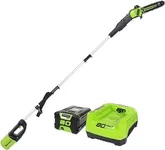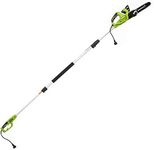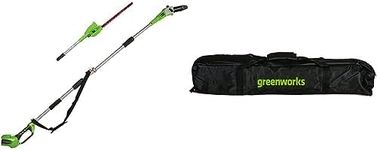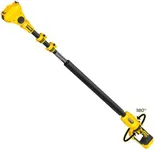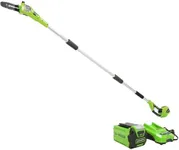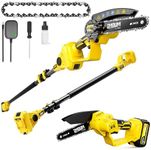Buying Guide for the Best Greenworks Pole Saws
When choosing a Greenworks pole saw, it's important to consider several key specifications to ensure you select the best model for your needs. Pole saws are essential tools for trimming and pruning trees, and the right one can make your yard work much easier and more efficient. Here are the key specs to consider and how to navigate them to find the perfect fit for you.Power SourceThe power source of a pole saw can be either battery-powered, corded electric, or gas-powered. Battery-powered pole saws offer the convenience of cordless operation and are generally quieter and lighter, making them ideal for small to medium-sized yards. Corded electric pole saws provide continuous power without the need for recharging but require access to an electrical outlet and can be limited by the length of the cord. Gas-powered pole saws are the most powerful and suitable for heavy-duty tasks and larger properties but are heavier, noisier, and require more maintenance. Choose a power source based on the size of your yard and the intensity of the tasks you plan to perform.
Bar LengthThe bar length of a pole saw determines the maximum diameter of branches it can cut. Common bar lengths range from 6 to 10 inches. A shorter bar length (6-8 inches) is suitable for light pruning and trimming smaller branches, making it ideal for residential use. A longer bar length (8-10 inches) can handle thicker branches and is better for more demanding tasks. Consider the typical size of the branches you need to cut when selecting the bar length.
Pole LengthPole length refers to the maximum reach of the pole saw, which is crucial for accessing high branches without the need for a ladder. Pole lengths typically range from 8 to 12 feet. A shorter pole length (8-10 feet) is sufficient for most residential trees and shrubs, while a longer pole length (10-12 feet) is better for taller trees and more extensive pruning tasks. Assess the height of the trees in your yard to determine the appropriate pole length.
WeightThe weight of a pole saw affects its ease of use and maneuverability. Lighter pole saws (under 10 pounds) are easier to handle and less fatiguing, making them suitable for extended use and for users who may not have a lot of upper body strength. Heavier pole saws (over 10 pounds) may offer more power and durability but can be more challenging to operate for long periods. Consider your physical strength and the duration of your typical pruning sessions when choosing the weight of your pole saw.
Battery Life (for battery-powered models)Battery life is an important consideration for battery-powered pole saws, as it determines how long you can use the tool before needing to recharge. Battery life is usually measured in ampere-hours (Ah), with higher values indicating longer run times. A battery with a capacity of 2.0 Ah to 4.0 Ah is generally sufficient for light to moderate tasks, while a battery with a capacity of 4.0 Ah or higher is better for more extensive pruning jobs. Think about the duration and frequency of your pruning tasks to select a battery with adequate life.
Ease of UseEase of use encompasses features such as ergonomic design, adjustable pole length, and tool-free chain tensioning. An ergonomic design with a comfortable grip can reduce fatigue and make the pole saw easier to handle. Adjustable pole length allows you to customize the reach based on the task at hand. Tool-free chain tensioning simplifies maintenance and ensures optimal performance. Look for features that enhance comfort and convenience to make your pruning tasks more manageable.

